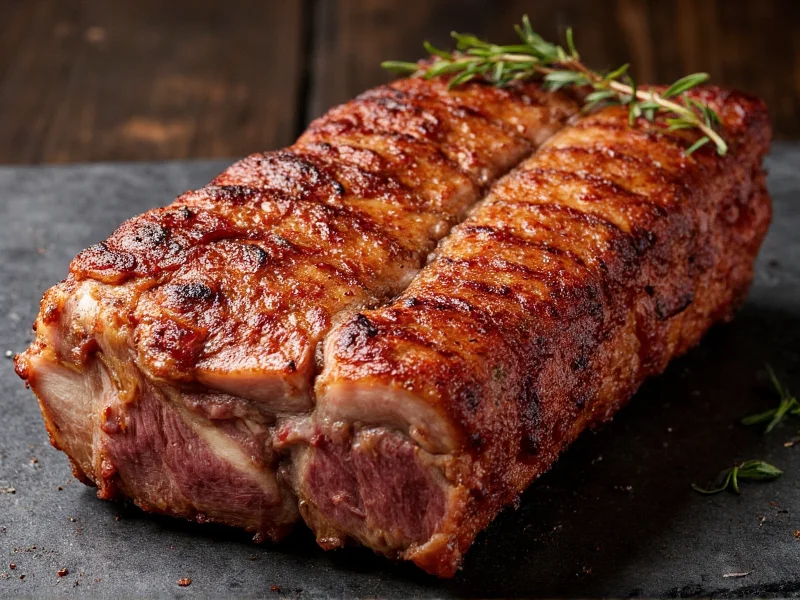Understanding meat terminology can prevent confusion at the grocery store or restaurant. The term “rib” refers to a specific anatomical section—the ribcage area—rather than indicating the animal source. This explains why you'll encounter pork ribs, beef ribs, and even lamb ribs in culinary contexts.
What Exactly Is Rib Meat?
Rib meat comes from the rib section of an animal's carcass, located along the upper torso. This area typically produces tender cuts with good marbling, making ribs popular for grilling and slow cooking. The specific characteristics vary significantly depending on the animal source:
| Animal Source | Common Rib Cuts | Distinctive Features |
|---|---|---|
| Pork | Baby back ribs, spare ribs, St. Louis cut | Smaller bones, higher fat content, more delicate flavor |
| Beef | Prime rib, short ribs, back ribs | Larger bones, richer beef flavor, often more expensive |
| Lamb | Rack of lamb, lamb rib chops | Distinctive gamey flavor, often served as premium cut |
Why Pork Ribs Are Most Commonly Associated With “Rib Meat”
In many grocery stores and restaurants, particularly in the United States, when you see “rib meat” without specification, it typically means pork ribs. This prevalence stems from several factors:
- Pigs have more rib sections per animal compared to cattle
- Pork ribs generally cook faster than beef ribs
- Cultural preferences in barbecue traditions, especially in Southern and Midwestern US
- Lower price point compared to premium beef rib cuts
However, assuming all rib meat is pork can lead to confusion or dietary issues, particularly for those with religious restrictions (halal, kosher), allergies, or specific dietary preferences.
How to Identify Rib Meat Source When Shopping
To avoid confusion when purchasing rib meat, look for these indicators:
- Product labeling: Reputable stores specify the animal source (e.g., “Pork Baby Back Ribs”)
- Price per pound: Beef ribs typically cost more than pork ribs
- Bone size: Pork ribs have smaller, more curved bones while beef ribs feature larger, straighter bones
- Marbling pattern: Pork fat appears more evenly distributed while beef shows distinct white streaks
- Ask the butcher: When in doubt, always request clarification about the meat source
Common Misconceptions About Rib Meat
Several misunderstandings persist about rib meat terminology:
Misconception: “All rib meat is pork”
Reality: While pork ribs dominate casual dining menus, professional butchers and international markets commonly offer beef and lamb ribs.
Misconception: “Baby back ribs are from young pigs”
Reality: The “baby” refers to the cut's size and tenderness, not the animal's age. Baby back ribs come from the loin area near the spine on any market-weight pig.
Misconception: “Prime rib is the same as ribeye steak”
Reality: Prime rib refers to a large roast from the rib section, while ribeye is a steak cut from that same primal section.
Why the Distinction Matters
Knowing your rib meat source affects several important considerations:
- Cooking methods: Pork ribs typically require 4-6 hours of smoking, while beef ribs may need 8-12 hours
- Dietary restrictions: Critical for religious observance or personal ethics
- Nutritional content: Beef ribs contain more iron and zinc but also more saturated fat than pork ribs
- Flavor pairings: Pork ribs complement sweeter sauces while beef ribs pair better with robust, smoky flavors
When following recipes, always verify whether they specify pork or beef ribs, as substituting one for the other without adjustment will significantly impact cooking time and final results.
International Variations in Rib Terminology
Meat labeling conventions vary globally, adding another layer of complexity:
- In the UK, “back ribs” typically refer to pork, while “standing rib roast” means beef
- Australian butchers often use “spare ribs” exclusively for pork
- European markets may label lamb ribs simply as “rack” without specifying the animal
- Some Asian markets sell goat ribs labeled only as “ribs”
When traveling or purchasing international products, don't assume rib meat refers to pork without verification.











 浙公网安备
33010002000092号
浙公网安备
33010002000092号 浙B2-20120091-4
浙B2-20120091-4